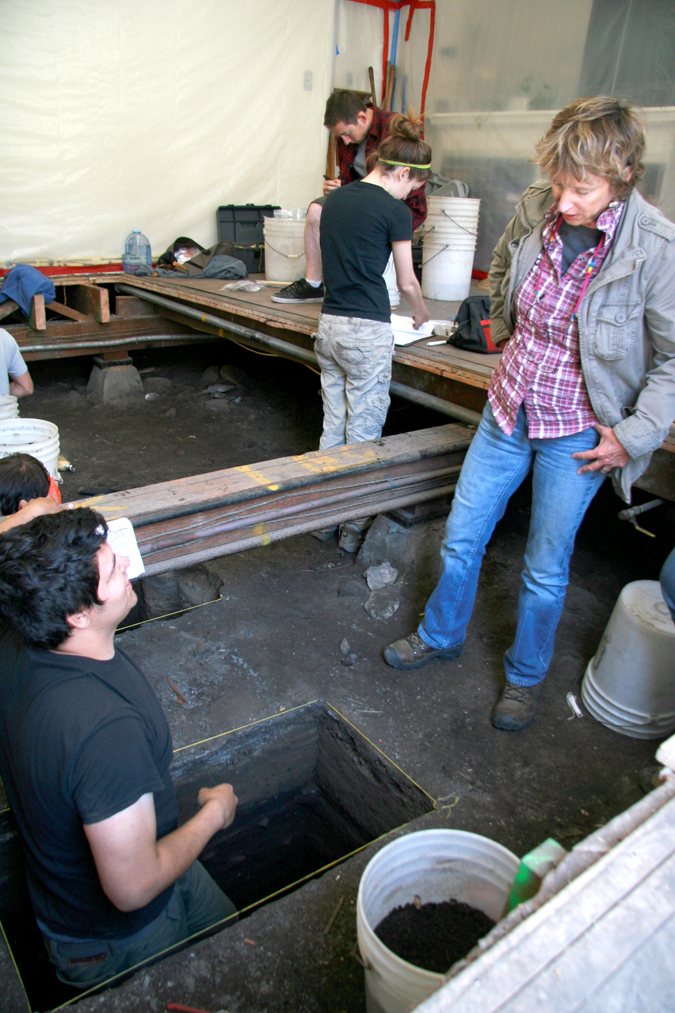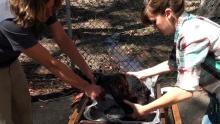

UC Santa Barbara professor of anthropology Lynn Gamble and her students were recently presented with a rare opportunity: Excavate a Chumash Indian site that might be the location of the original Santa Barbara.
"It's a really unusual situation," said Gamble, who specializes in California archaeology. "I've never dug inside a building before."
Under Gamble's supervision, her students dug three excavation units underneath a floor in the Veteran's Administration building near downtown Santa Barbara, unearthing items, and mapping their locations. Others picked through the excavated items, sifting and classifying them. The dig was a requirement for a proposed elevator project to be constructed at that spot.
Among the finds were typical items related to the coastal Barbareño Chumash, a seafaring band of Native Americans who took advantage of the hospitable climate, abundant resources, and convenient location of the area. Fish hooks made out of shells, bone and stone tools, arrow points, and one large, charred whale vertebra were among the items unearthed.
Of special interest to Gamble and her team were the hundreds of beads found at the site. The beads were used by the Chumash Indians as currency, and the excavation team can use them to date the site.
"I'm really into the shell beads because the Chumash did not use pottery," said Gamble, author of the book, "The Chumash World at European Contact: Power, Trade, and Feasting Among Complex Hunter-Gatherers." While other sites might be dated through changes in pottery styles, Gamble will be assessing the site in part through the beads, noting changes in how they were fashioned.
In 1542, when explorer Juan Cabrillo made contact with the Chumash Indians whose relics the excavation team had unearthed, the site, known as Syuxtun (Syukhtun), was a sprawling, thriving settlement.
"He met the village chief, which was a woman, at the time," said Regina Unzueta, the designated Chumash monitor whose job it is to oversee such excavations and protect the interest of her tribe.
For Unzueta, who can trace her lineage back six generations to Syuxtun, the excavation is more than business as usual. Her mother, Ernestine Ygnacio-Desoto, is the closest living relative to the inhabitants of the village, and Unzueta grew up in the place of her ancestors, which is now encompassed by the city's West Beach and downtown area.
"Can you imagine a village site, with houses ––‘ap is what they were called –– 75 ‘aps along the coast? That's a big village site," said Unzueta. By the mid-1800's, the village had disappeared, and the site became a place for cattle ranching activity, and, later, the Potter Hotel.
The fate of the elevator project depends on analysis of the excavation, and on consultation with Unzueta and Ygnacio-Desoto. If certain items were unearthed –– for example, human remains, which might indicate the presence of a historic, sacred gravesite –– the dig and the construction would have to take another direction, or stop altogether.
Additionally, the results could lead to further exploration of the site, which is at the foot of Burton Mound, an archaeologically rich site excavated in the 1920s.
"We're getting a tremendous amount of information that has great research potential," said Gamble.
While the descendents of the inhabitants of Syuxtun have the closest ties to the excavation, the research, in Gamble's opinion, is significant to all people in the area, as well as to anyone living in the state.
"This tells us about the past, and how people always wanted to live at this harbor," she said.
† Top image: Professor of Anthropology Lynn Gamble supervises students looking for clues to the possible use of the site thousands of years ago.
Related Links



